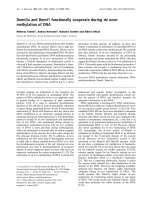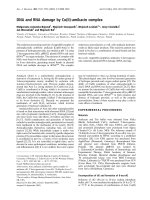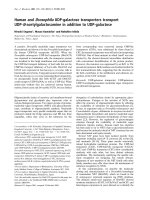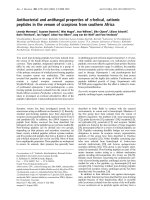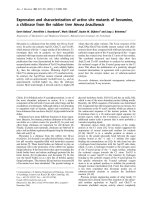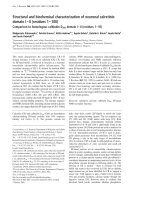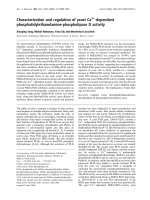Báo cáo y học: "Influenza and bacterial pneumonia – constant companions" ppt
Bạn đang xem bản rút gọn của tài liệu. Xem và tải ngay bản đầy đủ của tài liệu tại đây (122.66 KB, 2 trang )
In the previous issue of Critical Care, van der Sluijs and
colleagues [1] reviewed the pathogenesis of infl uenza and
bacterial pneumonia, particularly pneumococcal. ey
pointed out critical diff erences in pathogenesis between
various combinations of infl uenza and bacterial pneu-
monia. Four potential syndromes are possible. e classic
syndrome is bacterial pneumonia following an ante-
cedent infl uenza infection [2]. Bacterial pneumonia with-
out any antecedent viral infection has been associated
with a slightly better prognosis. Increasingly, concomitant
bacterial and infl uenza pneumonia have been described
and, while less common, appear to have a worse prog-
nosis than sequential infection. Important pathophysio-
logic diff erences between these syndromes are illustrated
in this review. Unexplored in their review is viral pneu-
monia without complication by bacterial pneu monia.
Primary infl uenza pneumonia without complication by
bacterial pneumonia appears to be common in the 2009
H1N1 infl uenza epidemic.
e diffi culty with separating these syndromes is the
inaccuracy of etiologic diagnosis for community-acquired
pneumonia (CAP). e CDC (Centers for Disease
Control and Prevention) has recognized this diffi culty
and conceded to report combined infl uenza and
pneumonia deaths since prior to 1900 [3]. e cause of
the majority of CAP cases remains undefi ned with the
usual culture-based approach (mainly blood cultures and
occasional sputum or more invasive respiratory cultures).
One of the lasting eff ects of the 2009 novel H1N1
infl uenza epidemic may be the increasing sophistication
and availability of molecular diagnostic tests for infl uenza
(and other respiratory viruses). During the peak of the
epidemic, reverse transcriptase-polymerase chain reac-
tion (RT-PCR) for infl uenza was available in many large
institutions within 8 to 12 hours of sampling. RT-PCR
clearly is faster than culture and much more sensitive
than the rapid infl uenza tests previously available. e
trophism for the lower respiratory tract characteristic of
the 2009 H1N1 infl uenza virus had diagnostic implica-
tions in addition to the pathophysiologic signifi cance of
higher incidence and severity of primary viral pneumonia
with acute lung injury/acute respiratory distress
syndrome [4]. e diag nostic issue was that patients
occasionally had negative nasopharyngeal RT-PCR tests
while lower respiratory tract samples were positive [5].
e frequency with which this occurs with other strains
of infl uenza or other respiratory viruses is unknown.
One caveat of the data regarding concomitant CAP is
that viral or atypical pathogen co-infection in these
studies was often diagnosed only by serologic conversion.
Sequential versus concomitant infl uenza and bacterial
pneumonia cannot be distinguished in this way. ere-
fore, the diff erential eff ect on mortality and morbidity of
concomitant versus sequential infl uenza and bacterial
pneumonia remains somewhat unclear.
Unfortunately, molecular diagnosis of bacterial infec-
tion lags behind that of viral. e best routinely available
diagnostic aids are the BinaxNOW urinary antigens
(Inverness Medical International, Cranfi eld, UK) for both
pneumo coccus and Legionella pneumophila. e pneumo-
coccal urinary antigen can increase the diagnosis of
Abstract
Sequential or concomitant in uenza and bacterial
pneumonia are two common syndromes seen in
community-acquired pneumonia. Inadequacies of
diagnostic testing make separating simple pneumonia
with either bacteria or in uenza from concomitant
or sequential in uenza with both microorganisms
di cult, although the novel 2009 H1N1 epidemic may
improve the availability of molecular testing for viruses.
Given the frequency of viral pneumonia and diagnostic
limitations, empirical antivirals may be underutilized
in community-acquired pneumonia. Thankfully,
increasingly e ective vaccines appear to disrupt this
synergistic relationship.
© 2010 BioMed Central Ltd
In uenza and bacterial pneumonia – constant
companions
Richard G Wunderink*
See related review by van der Sluijs et al., />COMMENTARY
*Correspondence:
Pulmonary and Critical Care, Northwestern University Feinberg School of
Medicine, 676 North St. Clair Street, Suite 14-044, Chicago, IL 60611, USA
Wunderink Critical Care 2010, 14:150
/>© 2010 BioMed Central Ltd
pneumo coccal pneumonia by 10% to 30% in prospective
studies. False-positives, often after a previous upper
respiratory infection such as otitis media, limit its
accuracy in children and HIV-positive patients. e
Legionella urinary antigen is limited to one serogroup of
L. pneumo phila which is neither the most common strain
nor serotype in certain areas of the world. In addition,
the assay picked up only 50% of cases and had almost
mutually exclusive results compared with a Legionella
PCR assay on sputum.
Whole-blood PCR for bacterial pathogens is generating
increasing interest. Recent studies of the pneumococcal
lytA gene have increased the number of patients
diagnosed with pneumococcal disease, and quantitation
appears to have additional prognostic signifi cance [6].
Similar prognostic signifi cance of quantitative PCR has
been demonstrated for a meningococcal gene.
e result of diagnostic limitations is that most
treatment for CAP remains empirical. Empirical anti-
biotics are the standard, but concern about delayed
antivirals in the recent pandemic signifi cantly increased
the use of empirical antivirals as well. Clearly, this
strategy makes the most sense for concomitant bacterial
and infl uenza pneumonia. Given the limitations of
etiologic diagnosis, the benefi t of empirical antibiotics for
occult bacterial pneumonia in patients with documented
infl uenza is unclear. Conversely, empirical antivirals for
culture- and urinary antigen-negative CAP patients may
be rational since viruses may be the etiology in up to 15%
of cases [7], with infl uenza being the most common viral
pathogen. e incidence of primary infl uenza or conco-
mitant infl uenza CAP is clearly as high as that of
community-acquired methicillin-resistant S. aureus
(CA-MRSA) [8] or Pseudomonas, for which empirical
anti biotics in the appropriate settings have been recom-
mended by guidelines [9].
e good news is that prevention of one appears to
prevent death from the other. e decrease in positive
infl uenza cultures and infl uenza-related deaths, particu-
larly among children, starting 6 to 8 weeks after the fi rst
dose of the novel 2009 H1N1 vaccine became available is
impressive [10]. Conversely, the pediatric conjugate
pneumo coccal vaccine decreased invasive pneumococcal
disease in infants as well as their adult caregivers [11],
even during peak years of epidemic infl uenza. Hopefully,
higher valent and adult conjugate vaccines will soon
become available to disrupt this lethal relationship even
further.
Abbreviations
CAP, community-acquired pneumonia; PCR, polymerase chain reaction; RT-
PCR, reverse transcriptase-polymerase chain reaction.
Competing interests
RGW is on the data safety monitoring committee for an adult conjugate
pneumococcal vaccine (originally Wyeth [Madison, NJ, USA], now P zer Inc
[New York, NY, USA]). In last 2 years, he has received a reimbursement of less
than $5,000 for time reviewing data and for meetings.
Published: 13 May 2010
References
1. van der Sluijs KF, van der Poll T, Lutter R, Ju ermans NP, Schultz MJ: Bench-to-
bedside review: Bacterial pneumonia with in uenza - pathogenesis and
clinical implications. Crit Care 2010, 14:219.
2. Ampofo K, Bender J, Sheng X, Korgenski K, Daly J, Pavia AT, Byington CL:
Seasonal invasive pneumococcal disease in children: role of preceding
respiratory viral infection. Pediatrics 2008, 122:229-237.
3. Heron M, Hoyert DL, Murphy SL, Xu J, Kochanek KD, Tejada-Vera B: Deaths:
nal data for 2006. Natl Vital Stat Rep 2009, 57:1-134.
4. ANZIC In uenza Investigators, Webb SA, Pettilä V, Seppelt I, Bellomo R, Bailey
M, Cooper DJ, Cretikos M, Davies AR, Finfer S, Harrigan PW, Hart GK, Howe B,
Iredell JR, McArthur C, Mitchell I, Morrison S, Nichol AD, Paterson DL, Peake S,
Richards B, Stephens D, Turner A, Yung M: Critical care services and 2009
H1N1 in uenza in Australia and New Zealand. N Engl J Med 2009,
361:1925-1934.
5. Rello J, Rodríguez A, Ibañez P, Socias L, Cebrian J, Marques A, Guerrero J,
Ruiz-Santana S, Marquez E, Del Nogal-Saez F, Alvarez-Lerma F, Martínez S,
Ferrer M, Avellanas M, Granada R, Maraví-Poma E, Albert P, Sierra R, Vidaur L,
Ortiz P, Prieto del Portillo I, Galván B, León-Gil C; H1N1 SEMICYUC Working
Group: Intensive care adult patients with severe respiratory failure caused
by In uenza A (H1N1)v in Spain. Crit Care 2009, 13:R148.
6. Rello J, Lisboa T, Lujan M, Gallego M, Kee C, Kay I, Lopez D, Waterer GW; DNA-
Neumococo Study Group: Severity of pneumococcal pneumonia
associated with genomic bacterial load. Chest 2009, 136:832-840.
7. Johnstone J, Majumdar SR, Fox JD, Marrie TJ: Viral infection in adults
hospitalized with community-acquired pneumonia: prevalence,
pathogens, and presentation. Chest 2008, 134:1141-1148.
8. Lobo LJ, Reed KD, Wunderink RG: Expanded clinical presentation of
community-acquired MRSA pneumonia. Chest 2010 Feb 19. [Epub ahead of
print].
9. Mandell LA, Wunderink RG, Anzueto A, Bartlett JG, Campbell GD, Dean NC,
Dowell SF, File TM Jr., Musher DM, Niederman MS, Torres A, Whitney CG;
Infectious Diseases Society of America; American Thoracic Society: Infectious
Diseases Society of America/American Thoracic Society consensus
guidelines on the management of community-acquired pneumonia in
adults. Clin Infect Dis 2007, 44 Suppl 2:S27-72.
10. Centers for Disease Control and Prevention - Seasonal In uenza (Flu)-
Weekly Report: In uenza Summary Update [ u/
weekly/].
11. Whitney CG, Farley MM, Hadler J, Harrison LH, Bennett NM, Lyn eld R,
Reingold A, Cieslak PR, Pilishvili T, Jackson D, Facklam RR, Jorgensen JH,
Schuchat A; Active Bacterial Core Surveillance of the Emerging Infections
Program Network: Decline in invasive pneumococcal disease after the
introduction of protein-polysaccharide conjugate vaccine. N Engl J Med
2003, 348:1737-1746.
doi:10.1186/cc8974
Cite this article as: Wunderink RG: In uenza and bacterial pneumonia –
constant companions. Critical Care 2010, 14:150.
Wunderink Critical Care 2010, 14:150
/>Page 2 of 2

